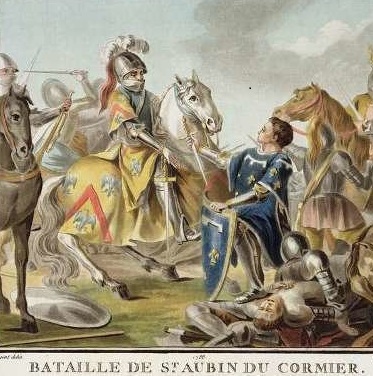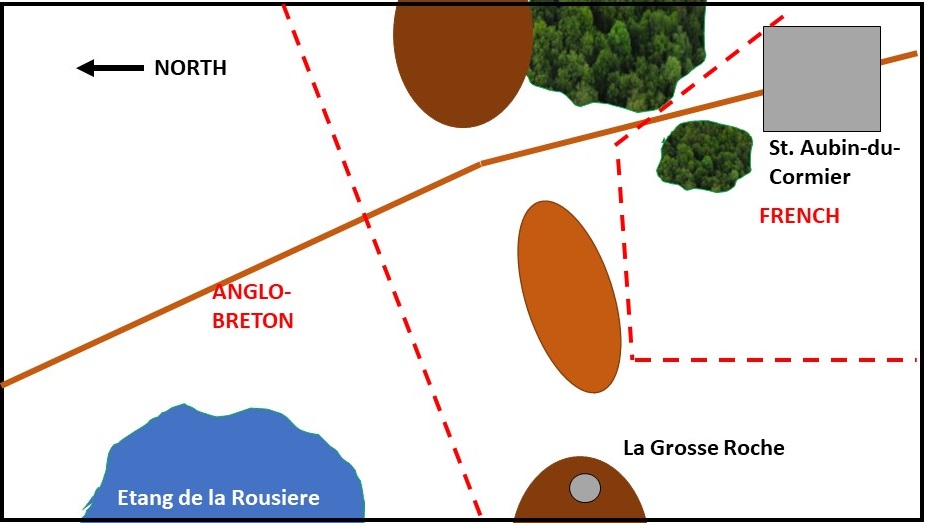Battle of St. Aubin-du-Cormier, 1488
A Scenario for A Bloody Dismal Fight


In July of 1488 the "Mad War" ("La Guerre Folle") came to an end. Francis II, Duke of Brittany, assisted by his traditional allies from the League of the Common Weal, unsuccessfully attempted to secure Breton independence. Charles VIII was king of France, but the revolt took place during the regency of Anne of Beaujeu. The battle marked one of the very early appearances of Landsknechts on the battlefield, according to some sources, fighting on the Anglo-Breton side. As Leon Le Meur writes, "The Battle of Saint-Aubin sounded the death knell of Breton independence."
The Anglo-Breton forces have encountered the French army, unprepared for battle, in a wooded area outside the town of St. Aubin-du-Cormier. Despite the urging of some Breton commanders to attack before the French had deployed, this was not successfully done, and the French artillery was able to cause considerable damage to the leading Breton formation. Exploiting a gap in the Breton lines, the French were able to break through and destroy their army.
The battle took place in open, hilly country, but the terrain figured into the battle. The Etang de la Rousiere is an impassable lake, and the Grosse Roche is also impassable. The hill to the East (top of the map) is very rough and provides cover. The woods behind are rough and provide cover. The hill in the center is an open slope, and does not slow movement. The village is considered rough and will provide hard cover.

The Anglo-Breton forces may set up anywhere to the north of the line shown on the map. The French must set up inside the area indicated (they were caught unprepared for battle by their adversaries, who foolishly gave them time to deploy.)
The Anglo-Breton camp may be set up anywhere within their initial placement zone.
The Breton Vanguard: (Marshal of Rieux, Overall Commander)
Foot Knights: 4 bases
Archers: 3 bases longbows
Levy: 4 bases
Crossbows: 3 bases
The Main Battle: (Alain de Albrecht)
Pikemen ("Landsknechts"): 3 bases
Archers: 3 bases longbows
Mounted Knights: 4 bases
Skirmishers: 4 bases Irregulars
Bombards: 1 base Cannon
The Rear Guard: (Lord Chateauxbriant)
Foot Knights: 4 bases
Light Horse: 2 bases Horsemen with Crossbows
The French camp may be set up anywhere within their initial placement zone, including in the village.
Vanguard: (Adrien de l'Hospital)
Swiss Pikemen: 2 bases
Swiss Halberds: 4 bases Footmen
Crossbowmen: 3 bases
Skirmishers: 4 bases Irregulars
Main Battle: (Louis II de la Trémoille, Overall Commander)
Footmen: 4 bases billmen
Mounted Knights: 4 bases
Archers: 3 bases Ordonnance longbowmen
Foot Knights: 4 bases
Culverins: 2 bases Cannon
Rear Guard: (Marshal Baudricourt)
Skirmishers: 4 bases Irregulars
Mounted Knights: 4 bases
Crossbowmen: 3 bases
The Anglo-Bretons will suffer a -1 penalty on their command rolls on the first turn of the game, to reflect their disagreements on how to proceed at the start of the encounter. The victory conditions are simple: the enemy host must be broken.